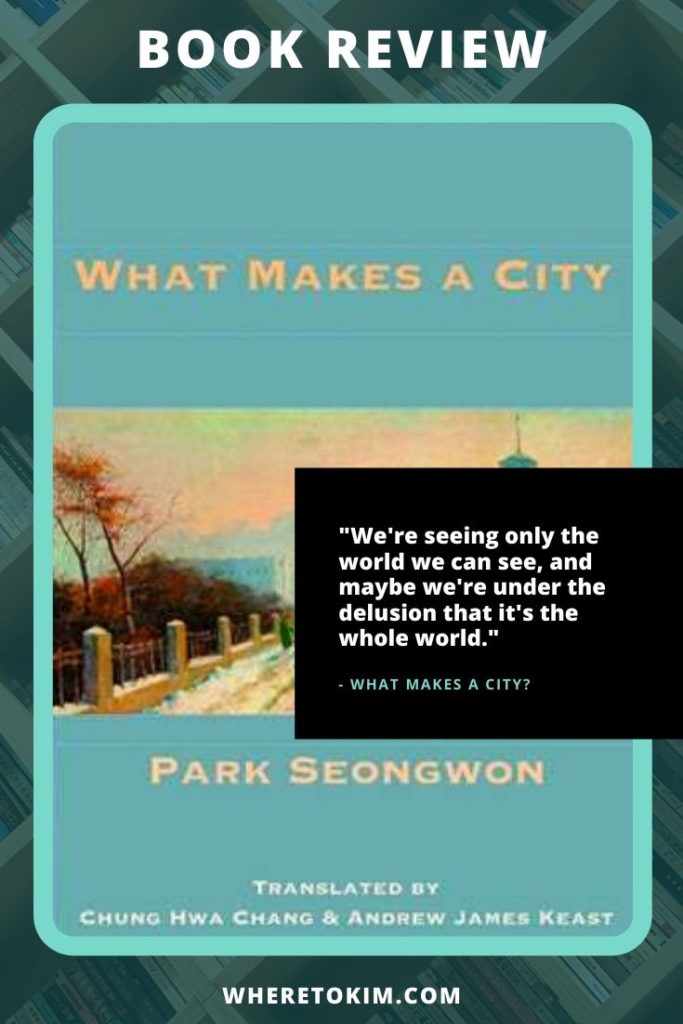What Makes a City? by Korean author Park Seongwon is a short story collection with intriguing stories. All of them deep and moving, discussing heavy themes in a light and dark humor kind of way.
What Makes a City? Synopsis
What Is It That Makes Up a City? provides the reader with an intelligent perspective on the strange culture of our times and a series of adventures through which we explore universal human problems. Family, education, the media, popular culture, technology, alienation, financial power or the lack thereof . . . These are among the most prominent components of the eight stories which comprise this book, in which characters struggle—sometimes in despair, but usually with a sense of humor—to understand or at least accept their place in a world that often makes no sense.
Book review
“People lived to be on time, and people were able to go on living as long as they stayed within time. In my dad’s words, leaving – getting out, to the outside of time – is, in fact, death.” Time plays a huge role in the stories in What Makes a City? and especially in By Motorhome to Ulan Bator I and II. While most humans are subject to time’s regime, the nomad is different as the nomad won’t be tamed by time. He is very much alive even though he lives outside of time. If we draw the parallel with the digital nomads of our time I am not sure this holds up. While digital nomads have control over their day to day planning, most of them still have to abide by deadlines.
This brings me to the irony of the dad’s lottery deadline in By Motorhome to Ulan Bator I: there is just no time to waste for the main characters of the story. The kids obviously haven’t mastered the nomad way of thinking. What do they need in life to feel satisfied? When time seems to stop, will they find peace?
This story is followed by the first part of the story the book takes its name from; a story about love and loss, but also about a person being only one small part of a city. “The city, as if it had become a part of those earliest hours, was peacefully interred. He imagined that he was the only one there who could breathe and move, and again he was afraid.” What would it be like to be the only one moving in a big city? Not simply at night, but in general? Or feel like you’re the only one there while you’re actually the one standing still and everyone else is moving. The poor man is in shock and feels like he is dreaming. What do you do when you have no one? Even the little girl doesn’t have the power to draw him back. They could find each other in their loneliness, yet the way the story ends you have a bad feeling about what will happen in the next part of this story and as expected What Makes a City II is one of the darker and sadder stories.
The second part of By Motorhome to Ulan Bator is set in the future. It is about the interconnectedness of people and about meeting people that aren’t part of your usual circle. Even though the circumstances of the main character aren’t great, he still looks towards the future. “The past is a dead thing, and if it isn’t dead, I’ll kill it. So I just dream about the future and about the fantastic.” The writer hits the right tone every single time. I find it very impressive how he can make the characters come to life. “As I ran, I remembered again and again my father’s saying that the nail driven in so deep wouldn’t come out. For me too, it’s over now.” Nothing lasts forever. Hold on to each other while you can and love each other deeply. The world changes, yet not that fast that all will be better in the future. Unless you screw up your ‘now’…
The stories By Motorhome to Ulan Bator I and II and What Makes a City I and II impressed me the most because of the way they made me experience the turmoil and misery but also the moments of joy of the characters. On Logic was a completely different story, amusing me with the crazy turn of events. The main character got himself in such a mess that he deserved to get into trouble because of it.
The Story of a Wife deals with truth and lies and the power of secrets. “Only when a certain amount of a secret has escaped does a secret have value.” It is hard to break the pattern and do better than your parents. You can somewhat understand the main character. I mean, who doesn’t want to feel special sometimes? Especially if you feel your life is perfectly ordinary. “What we see is not the only truth. And not all of what we see is true.”
A Rejected Story also discusses ordinary people. It is about a city in which inhabitants are all the same; they watch the same series and wear the same clothes. Where are their unique identities? From an outside view, city residents are just like a colony of ants. “We’re seeing only the world we can see, and maybe we’re under the delusion that it’s the whole world.”
The last story in the book, Division, is about choices. Will you stand up for what you know is right, or choose your own survival? Never an easy choice especially when the choice you make is not final.
While reading the stories you come across many Korean cultural aspects like funeral habits, mountain hiking and the value of wild ginseng. The importance of marriage and having a family to rely on takes a prominent place in all stories.
Most stories are both dark and light at the same time with funny and positive thoughts over a darker undercurrent. They deal with heavy themes, like pedophilia, affairs, searching for someone, searching for truth, secrets, love, and loss. Yet with a sprinkle of hope, somewhere. Characters come and go and make an appearance in later stories. You recognize them immediately as it is not easy to forget about their struggles. All stories together tell one bigger story about time and about being a part of something bigger. But not a unique part.
After some of these stories I put the book down to think about what I had just read. The beautiful prose and memorable characters and their thoughts stayed with me. The writing style (or translation) made the stories more intense and had the power to draw my mind into the world inside the book. The book provides you with possible meanings and messages, but you can come up with many more while considering how it applies to your life and the way you live. What Makes a City? is not a book to read from cover to back, but rather one where you read a story a day and ponder on the meaning of that single story.
This is easily one of the more interesting books I read this year and also a book that I will reread every now and then. It inspires me to become a better writer and to add more ‘flow’ to my sentences.
Translated from Korean by Chung Hwa Chang and Andrew James Keast.
Interested?
Get your copy of What Makes a City? from Amazon.







